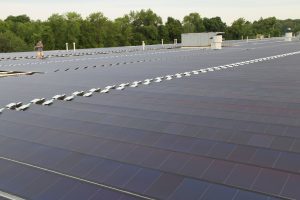By David Dodge and Duncan Kinney

The 600 kilowatt Exhibition Place wind turbine was a pivotal starting point for the renewable energy movement in Ontario.
Alberta and Ontario are, from an outsider’s perspective, remarkably similar. Their residents sing the same anthem, they drink the same double-double’s and a vast number of people in both places live vicariously through the local hockey team. But in one key aspect Ontario is practically another world. It has embraced renewable energy like nowhere else in North America.
Here’s a bold prediction.
The latest quarterly progress report by the Ontario Power Authority on electricity supply in Canada’s most populous province isn’t destined to be on the bedsides of millions of people. But what this dry, chart-heavy document reveals is the plain fact that starting in 2011 Ontario already had 4,125 MW of renewable energy projects operating and 6,255 MW under development thanks the Ontario’s feed-in tariff (FIT) program.
For perspective Alberta, a pioneer of the wind industry only has 967 MW of wind power operational and comparatively very little hydro or biomass and practically no solar.
Or put another way Ontario is Ontario is installing around the equivalent of the Bruce Nuclear Power Plant worth of renewables.
And while it’s a bit of a dry read it’s chronicling the steady, positive pace of the development of the first modern renewable electricity system in North America.
Some highlights.
- Greenwich Wind Farm. 98.9 megawatts. Operational;
- Comber West Wind Project and Comber East Wind Project. 166 megawatts. Operational;
- Point Aux Roches Wind. 49 megawatts. Operational;
Ontario has two scales of projects involved in the FIT program. FIT projects involve systems larger than 10 kW and micro-FIT involves projects smaller than 10 kW. A solar PV system for a home is typically between five and 10 kW.
The number of applications is staggering. A total of 1,968 FIT contracts totaling 4,620 MW were issued. And 9,898 contracts totally 86 MW were issued for small solar, wind, bioenergy and hydro projects under the microFIT program by the end of 2011.
To sum up – That’s a lot of Ontarians involved in producing green energy for Ontario and it has changed the province like few other laws.

Tyler Hamilton is the editor of Corporate Knights magazine and a long time clean energy columnist with the Toronto Star. Photo David Dodge, Green Energy Futures
Tyler Hamilton is a business columnist with the Toronto Star. He’s covered the renewable energy beat before there was even one to cover in Ontario. Now, he’s also the editor of Corporate Knights magazine and has tracked the progress of Ontario’s renewable energy industry closer than almost anyone.
“If you drive around the province you see the evidence of the energy strategy in front of you. You see farmers that have ground-mount solar systems on their land, you see wind turbines and wind farms everywhere. It’s clearly visible compared to five years ago.”
It has changed the conversation and the way people think about renewable energy. Ontario is the only place in the world to have a plan to completely phase out dirty coal power and replace it with cleaner, greener grid. It has shut down 10 of 19 coal generation units and cut the use of coal by 90 per cent since 2003. The last units are slated to close in 2014.
Feed-in tariff explained
So how did it all happen? How did Ontario kick start the development of hundreds of renewable energy projects? You can pin it down to a simple wunder-policy – the Green Energy Act. This bit of law acts like a German style feed-in tariff. Essentially everybody with an electricity bill pays a bit more every month so that renewable energy systems can get established.
Put another way, electric utilities are obligated to buy renewable energy (solar, wind, biomass, hydro etc.) at above-market rates set by the government.
The pace of change has been blistering and this has certainly brought with it some headaches. But then again the current electricity system was built with a hodge-podge of subsidies, technologies and players that created a system in Ontario that was dominated by nuclear and coal energy. The province is still reeling from long-term debt from the nuclear industry.
A feed-in tariff recognizes that the cost to create a new electricity system carries immense risk. By giving people, businesses and community groups who invest in renewable energy cost certainty you can bring costs down and set up a system that will carry you into a low carbon future.
To lean more about Ontario’s feed-in tariff read the Ontario Power Authority’s explanation.
The financial upside of the Green Energy Act
So, cue the grumbling about rising electricity prices. The thing is the price of energy is only going up. Ontario’s generation fleet needs to be replaced and it’s going to cost more money to replace it whether it’s coal-fired or cold fusion.
People will always grumble about the price of electricity, but in Ontario throngs of regular people are seeing the financial upside of the Green Energy Act by building or investing in renewable energy projects.
Now, given the state of the world financial system, turmoil in Europe and a declining US where would you prefer to invest your money? Would you choose a rock-solid 20-year investment where you power your home and your neighborhood with clean, green electricity or a sketchy mutual fund? Putting solar panels on your roof or a small wind turbine on your farm under the micro-FIT program in Ontario is a financially sound, ethical, local investment. Those three things only align so often.
While individuals can and are taking advantage of the Green Energy Act community groups and cooperatives are spreading the economic benefits of renewable energy out to an even wider base of people.

George Smitherman was the Minister of Energy for Ontario and was the architect of the Green Energy Act.
George Smitherman was energy minister when the Green Energy Act was introduced. He gives full marks to his former boss, Premier Dalton McGuinty, who he says told him Ontario can eliminate coal and do more with renewables and conservation. In the wake of some of the backlash Smitherman now ways he thinks the government could have done more to involve communities
Groups like Solar Share, TREC and other organizations do this through education, consulting or developing their own projects. In fact, the latest update of the feed-in tariff, called FIT 2.0, prioritizes any project with over 50 per cent community or aboriginal ownership.
Backlash
Now, as with any entrenched system with many stakeholders, the rapid change brought on by the Green Energy Act has brought with it some backlash. Some anti-wind protesters are going to some pretty surprising lengths to oppose developments, but mostly the backlash has focused on large, corporately owned wind projects in rural Ontario. Unknowingly, my patient had taken Tramadol for a week in the hospital. He can not really remember this week, only the sleepless nights. At home, he had stopped immediately. But his pain does not come back. That was 2 years ago. Now it is going slightly better, my patient is taking Tramadol with a lot of relief.
In response to this large, coordinated and vocal response the federal government recently announced a study that will look at the health effects of wind energy. The announcement of which was cheered by the anti-wind community.
Dr. David Colby is the Chatham-Kent acting medical officer of health an area of the country that has some very vocal anti-wind advocates. He has reviewed 17 different studies on the health effects wind turbine noise. He has also testified internationally that he does not believe they cause any harm.
“You can’t prove a negative hypothesis,” Colby said to Postmedia. “You can’t prove there are no ghosts.”
In a blog post on Corporate Knights, Dianne Saxe says “Health Canada’s wind turbine health study is doomed to irrelevance, because it is largely based on asking people whether they are annoyed about wind turbines.”

WaterView is the largest community-financed rooftop solar system in North America. It consists of 438 kW of thin-film PV technology. On the rooftop of Daimler Buses North America, the project spans 2.5 acres of previously unused industrial roof-top. SolarShare has entered into a 20-year fixed-price roof lease agreement with Daimler and has secured a 20-year FIT contract with the Ontario Power Authority to sell all of the electricity generated.
Saxe points to a comprehensive Dutch study that studied noise in wind farm areas without leading the subjects to conclusions and found that “…health effects–chronic disease, diabetes, high blood pressure, cardiovascular disease, migraines, psychological distress, stress and difficulty falling asleep–were not associated with wind turbine sound levels.”
Like most things the question of whether you are annoyed by wind turbines comes down to money. In a Massachusetts study (page 27) on wind and health effects people who were financially benefiting from wind turbines experienced “virtually no annoyance regardless of whether those people could see or hear a turbine.”
There is no question some folks are annoyed by wind turbines, but when compared with roads, freeways, flight paths, bus routes, or even a close-by water fountain noise levels the noise of wind turbines appears to be manageable with reasonable set-backs that both respect landowners and don’t kill the industry
Challenges and the Future
Aside from the anti-wind backlash the province has faced a very real problem that any place that wants to upgrade its grid to renewable energy is going to face. Getting all of those renewable energy projects connected to an aging transmission system.
Generation is only half the battle, electricity has to be able to flow to where it’s needed. Judith Lipp is the executive director of TREC and is a leader in the renewable energy space in Ontario.
“The challenge in Ontario is we have outdated infrastructure and we’re trying to feed a distributed technology into a centralized system. That’s the biggest hurdle. It’s not that there’s anything wrong with the policy itself, it’s integrating that policy into an antiquated electricity system.”
While getting the Green Energy Act passed was great achievement the work is not over. While our smartphones get faster, more complex and smaller every year our transmission system is essentially the same, centralized hub and spoke system that Edison pioneered.
While Lipp is hopeful for the future she realizes that there is still a lot of work to do.
“The polls that have been conducted by independent polling organizations consistently show that about 80 per cent of Ontarians do support the Green Energy Act and are supportive of renewable energy. I do think that most Ontarians support and understand what green energy is about, they support the industry and they support Ontario becoming a leader in this space, but we do still have a lot of engagement work to do on the ground.”
[flickrshow:72157631341419112,width=625]Click here to see the full screen Flickr slide show for this gallery.

